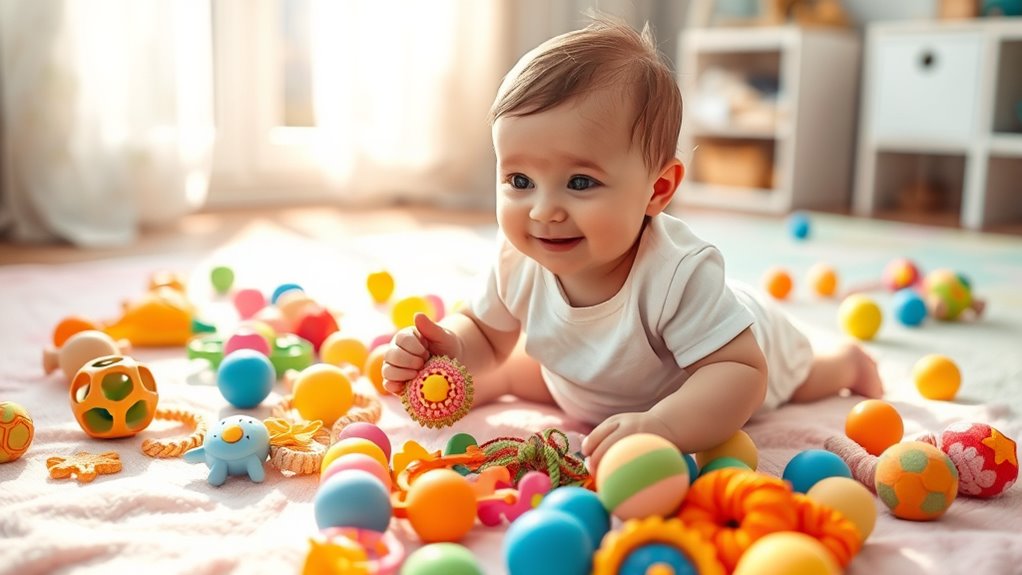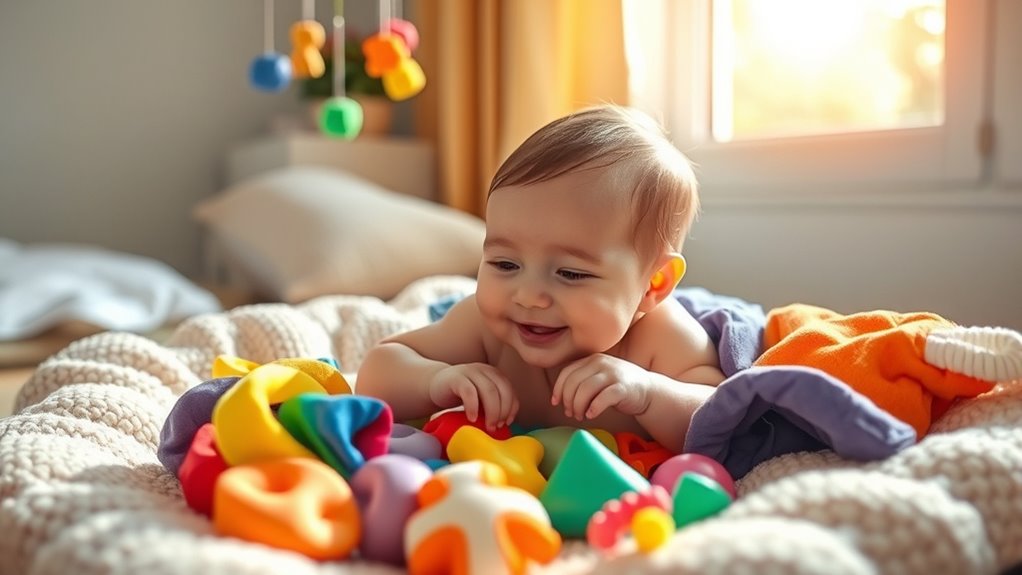Sensory play is crucial for your baby’s growth and development. Try texture baskets filled with soft materials like velvet and corduroy, or create colorful mats for tummy time. Engaging with rattles and crinkly books enhances auditory exploration, while high-contrast images and colorful mobiles captivate their sight. Encourage movement with crawling activities and fun balls. These activities spark curiosity and creativity. Discover more exciting ideas to boost your baby’s sensory experience and support their learning journey.
Key Takeaways
- Create a texture basket with various materials like wool and velvet for tactile exploration during playtime.
- Use high contrast images and colorful mobiles to captivate your baby’s visual attention.
- Incorporate rattles and sound tubes to stimulate auditory exploration and encourage movement.
- Set up sensory bins with oats or themed items for burying and discovering hidden treasures.
- Engage your baby with interactive learning toys that promote cognitive and social skills through play.

Sensory play is a vibrant way to engage your baby’s developing mind and body. It involves activities that stimulate the five senses: touch, taste, smell, sound, and sight. By incorporating sensory play into your baby’s routine, you can enhance their cognitive development, motor skills, and creativity. The beauty of sensory activities lies in how adaptable they’re for different ages. For younger babies, focus on passive sensory experiences, while older babies can dive into more active play.
When it comes to visual stimulation, high contrast images like black and white shapes are particularly effective for tiny eyes. Hang colorful mobiles above the crib to capture their attention, or use mirrors to help them recognize their reflections. You might also enjoy showing family photos, pointing out smiling faces to build connections. Creating sensory boards with various textures and colors can also provide endless visual excitement.
Don’t underestimate the power of tactile experiences. Fill texture baskets with materials like wool, corduroy, and velvet for your little one to explore. Themed sensory boxes can be a hit too, filled with kitchen utensils or soft fabrics for them to touch and grasp. Make tummy time more engaging by using colorful mats, or let them explore shaving cream with their hands. An oat sensory bin, where you bury small objects for discovery, can turn any playtime into an adventure.
Auditory stimulation is just as crucial. Rattles and music can get their little ears dancing, while sound tubes provide an engaging auditory experience. You might even attach bells to their feet, offering auditory feedback as they move. Reading crinkly books is another fun way to introduce sound exploration, or you can create bubble sounds to spark their curiosity.
Don’t forget about olfactory experiences. Introduce spices and herbs to stimulate their sense of smell. Child-safe essential oils can also be a delightful part of their sensory exploration. Expose them to the scents of flowers like roses or lavender, and let them discover various food smells during mealtime. You can even create scented playdough for them to enjoy.
Lastly, kinesthetic and balance activities are essential for development. Enhance tummy time with sensory mats, or encourage crawling over and under objects. Playing with balls of different textures can add excitement, and activities like kicking balloons can be a blast. Additionally, engaging in interactive learning toys can further support their cognitive and social skills through play.
With all these ideas, your baby’s sensory play will flourish, helping them grow and learn in a fun, engaging way.
Frequently Asked Questions
What Age Is Appropriate for Sensory Play Activities?
Sensory play activities are appropriate for all ages, starting from birth. You can engage your infant with simple experiences like tummy time and skin-to-skin contact.
As they grow into toddlers, introduce sensory bins and taste-safe materials to foster exploration. For preschoolers, activities that involve scooping or pouring enhance fine motor skills and cognitive development.
No matter the age, sensory play supports curiosity and learning while helping them navigate their environment effectively.
How Can I Ensure My Baby’s Safety During Sensory Play?
You might think letting your baby explore sensory play is simple, but safety’s the real challenge.
To keep your little one safe, always supervise them and choose non-toxic, easy-to-clean materials. Avoid small parts to prevent choking hazards and ensure the play area’s free from risks.
Regularly inspect toys and modify activities for their age. While sensory play’s all about fun, a little vigilance goes a long way in ensuring their safety and comfort.
Are There Any Allergies to Consider With Sensory Materials?
Yes, there are several allergies to consider with sensory materials.
You should be aware of common allergens like gluten in playdough, latex in balloons, and nuts in certain materials.
It’s crucial to read labels and choose hypoallergenic options to prevent reactions.
Conducting a pre-play assessment and communicating with other caregivers helps identify risks.
Always supervise your child closely and be prepared with allergy treatments, like an EpiPen, in case of an emergency.
How Long Should Sensory Play Sessions Last?
How long should your sensory play sessions last?
Typically, for infants, aim for 5-10 minutes, while toddlers can handle 15-20 minutes.
Pay attention to your child’s interest and mood; if they show signs of distraction, it’s time to wrap up.
You can extend sessions by incorporating a variety of activities and smooth transitions.
Engaging with your child actively can also help keep them focused and interested longer.
Can Sensory Play Help With Developmental Milestones?
Yes, sensory play can definitely help with developmental milestones.
When you engage in activities that stimulate your child’s senses, you’re enhancing their cognitive, motor, emotional, and language skills. These experiences encourage problem-solving, fine-tune motor control, foster social interactions, and boost language development.
Conclusion
In the world of sensory play, simple treasures can spark endless joy. As you watch your baby explore textures, sounds, and colors, you’ll see their curiosity bloom like a flower in spring. Embrace the mess of finger paints, the giggles from splashy water play, and the quiet focus on soft fabrics. Each moment spent in sensory exploration fosters growth and connection, turning ordinary days into extraordinary memories. So dive in, and let your baby’s imagination soar!









